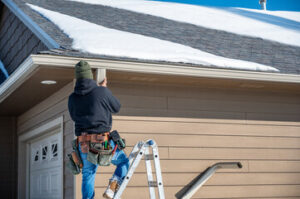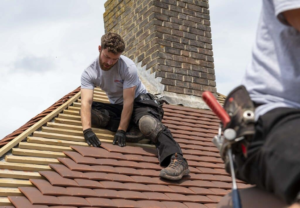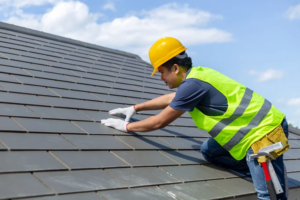Gutter installation is an essential home improvement project that protects your house from water damage and foundation issues. However, the gutter replacement timeline depends on several factors. Open communication with your contractor allows you to anticipate the work timeline.

Start by identifying the lowest points on your roof slope and cut holes for downspout outlets. Securely fasten each downspout section and test with a hose to ensure proper flow and no leaks. Visit https://guttercleaningcharlestonsc.com/ to learn more.
Gutter systems protect roofs and property from water damage, but they can also be affected by various weather conditions. Understanding how different climate patterns can impact gutter functionality and how to safeguard them against environmental factors is critical for ensuring their longevity and optimal performance.
Choosing the right season for gutter installation can minimize complications from inclement weather. The best time for the job is spring, when temperatures are mild and the humidity levels are low. However, gutters can be installed year-round, as long as the weather permits.
The most important aspect of proper gutter installation is thorough preparation. This includes determining the size and layout of the gutter system and assessing the state of the roof, including any loose shingles or cracks that need to be repaired. In addition, it is essential to familiarize yourself with local regulations regarding the use of specific gutter materials and styles. Failure to do so can result in costly fines or forced changes, so it’s vital to learn as much as possible before beginning the project.
In addition to ensuring that all necessary precautions are taken, it is essential to review the current weather conditions and forecasts before beginning the installation process. This will help prevent unexpected interruptions and allow homeowners to reschedule the installation for when the weather is more favorable. In addition, establishing contingency plans and backup solutions in the event of rain or other severe weather may help mitigate any delays or safety risks.
A variety of weather conditions can affect gutters, ranging from heavy rainfall to high winds. The most common cause of gutter problems is the accumulation of ice and snow, which can lead to blockages that inhibit water flow. Ensure that your gutters are sized and positioned properly to keep them free of obstructions.
The location of downspouts is another crucial factor that can affect gutter function. Ideally, downspouts should be placed along the roofline and pointing away from the house to avoid clogging. Moreover, they should be secured to the downspout outlet and house with brackets for stability and durability.
Roof Structure
Gutters are pivotal to a building’s water management, protecting the roof, walls, windows, and foundation from moisture damage. They are fixed along the edge of a building and channel rainwater towards downspouts, which carry water to an underground drainage system or rain barrel. Keeping the gutters clear of debris, clogs, and overflow is essential to their functioning. Regular cleaning and inspection is a must for optimal gutter performance.
The roofing material and design is a key factor that influences the gutters’ functionality and longevity. Choosing the right roof materials and designs heightens the effectiveness of gutter systems, minimizing problems like discoloration, rusting, leaking, and deterioration. This also enables proper integration with the roofing system, allowing for an effective channeling of water.
A crucial component in this regard is the slope of the roof. A steeper slope facilitates faster water runoff, requiring a larger gutter to accommodate the increased volume of rainfall. A skilled and experienced contractor can ensure that a gutter system is properly sized to prevent clogs, overflow, and other related issues.
Another important consideration is the type of downspout that a homeowner prefers. A metal downspout offers durability and strength, while plastic downspouts are more affordable but less sturdy. However, both types of downspouts are necessary to prevent a clogged and overflowing gutter, as they are the primary channels for drainage.
Choosing a professional gutter installation service will help you avoid costly repair and replacement costs in the future. Whether you are replacing a single gutter or a complete system, the right professionals can deliver flawless results that will complement your home’s exterior and protect your property from water damage.
Downspouts
The downspout is more than just a simple tube attached to your gutter system. It’s the knight in shining armor that protects your building from rainwater damage by directing the water away from the foundation. If your downspouts aren’t positioned properly, it can cause expensive basement flooding and structural damage.
Downspouts are connected to the gutter system at the roof’s edge and run vertically down the side of your building. They’re designed to drain water away from the foundation and into a stormwater drainage system, but they can be compromised by overflowing, clogs, and incorrect slope or pitch.
Gutter downspouts are available in a variety of sizes to suit different roof types and structures. You can also find downspout covers to prevent debris from clogging the channels. They’re available in a range of styles and colors, so you can match them to the color of your gutters or siding for an integrated look.
Downspout size and placement is crucial because it determines how effectively your gutter system works. If the downspout isn’t big enough to handle the amount of water it collects, you’ll experience overflow and damage to your siding or fascia. Downspouts that are too close to your foundation can lead to basement flooding, leaky walls, and cracked foundations.
A professional can help you determine the best downspout size and positioning for your home or business. They’ll use a tape measure to calculate the total linear footage of your gutters and downspouts, then walk along the length of each straight section. They’ll also check for rust spots, gaps, cracks, and other signs of damage.
Once they’ve determined the ideal downspout size, they can install them to ensure that your gutter system functions correctly. They’ll take into account the slope of your property and any nearby landscaping to make sure downspouts are positioned in the right place to avoid water pooling or causing damage. They’ll also ensure that the downspouts are long enough to drain away from your foundation. The right downspout placement can also protect your soil, preventing it from becoming saturated and eroded.
Timeline
The timing of gutter replacement can be influenced by numerous elements, from the size and complexity of your home to local weather conditions and seasonal climate shifts. However, the key to navigating these factors is clear communication with your professional contractors and setting feasible expectations for your project’s duration.
Whether you’re replacing old gutters or installing new ones, the first step of a typical installation process involves conducting an inspection of your roofline and fascia boards to identify any underlying issues that might need to be addressed before moving forward with your project. For instance, rotting fascia or soffits may require repair before your new gutter system can be installed properly. Additionally, if you’re opting for more complex gutters like copper or steel, they typically take longer to install than aluminum varieties.
For most homeowners, a complete gutter replacement project takes around two to four hours to finish, depending on the size and complexity of your home’s roofline. This includes the removal of your existing gutters, the installation of downspouts, and a thorough clean-up of the work area. Adding additional features like gutter guards or heating elements for winter drainage can also increase the duration of your project.
Gutter installation should always be conducted by a trained and licensed professional, as the process is highly technical and requires special safety gear to navigate the heights of your roof. Additionally, a professional approach ensures that all phases of the project—from the careful removal of your existing gutters to the precise installation of your new ones—are performed thoroughly and accurately.
While you should expect minor setbacks to arise throughout any home improvement project, a reputable contractor will have a clear plan in place for handling unexpected challenges or changes. For example, if your contractor is experiencing a peak season or has a backlog of appointments, they will likely take extra time to communicate clearly and prioritize your project. They will also be more likely to offer flexible scheduling options that fit your schedule. Ask your contractor about their process for communicating any delays or expected add-ons to your gutter replacement project.


